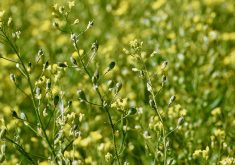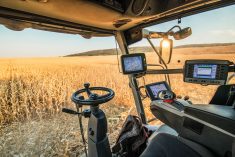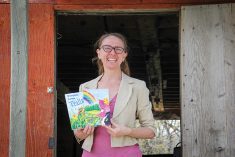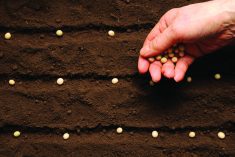Camelina, calendula, niger, zero-tannin fababeans and hemp are some of the non-traditional crops that have been sprouting up in Manitoba fields in recent years.
All of them can be grown successfully in this region, judging from the results from the Western Ag Diversification Organization’s (WADO) test plots last year.
Of them all, camelina has been getting the most attention, with radio ads calling on farmers to contract acres for the novel crop, also known as false flax.
After about five years of variety, fertility and seeding date trials at various locations in the province, it appears that a late fall, dormant-seeding strategy is the best for the low-input, omega-3-rich oilseed, according to Melita-based diversification specialist Scott Day.
Read Also

Mazergroup’s Bob Mazer dies
Mazergroup’s Bob Mazer, who helped grow his family’s company into a string of farm equipment dealerships and the main dealer for New Holland machinery in Saskatchewan and Manitoba, died July 6 from cancer.
“Camelina is very tough. It can handle very cold temperatures in the spring,” said Day, in a presentation at the Man-Dak Zero Tillage Association annual workshop in Brandon last week.
“We found that the first week of November gave us the best results.”
COMPETITIVE SEEDS
The tiny-seeded crop is very competitive, and although it has been touted as a lower-input alternative to canola and has clocked fabulous 5,000-pounds-per-acre yields in other areas, Day said Manitoba trials show it responds well to nitrogen, but has so far produced only flax-like yields.
Disease, most likely fusarium wilt, wiped out some plots, so farmers may need to be careful about where they use camelina in a rotation, he added.
Calendula, also known as pot marigold, showed some promise last year, despite cool weather during the driest spring on record for the Melita area.
Interest in it has been driven by a Dutch company, which is exploring the possibility of contracting up to 50,000 acres in the U. S. and Canada of the essential oil-containing flower that has potential for use in industrial oils, paint and skin lotions.
A mid summer outbreak of grasshoppers in Melita wiped out neighbouring flax and canola plots, but left the calendula untouched, said Day.
NEEDS FROST
The crop is very weed competitive, has few insect problems, but needs a hard frost before harvest. Group 1 herbicides, particularly Dual, worked best. Although it is a short plant, it can be handled with a regular combine using the same settings and speed as for flax.
The seed pods make it a very low-density crop in terms of weight – much like sunflowers – but a plot near Brandon yielded 1,200 pounds to the acre. Yields in the Netherlands are typically around 2,000 pounds per acre.
“It is a crop that we can grow. If you see a contract out there, it might be worth growing on 40 acres or something like that,” said Day.
Niger, an African oilseed used mainly for bird food in North America, yields about 600 to 700 pounds per acre in Manitoba plots, but bird predation has been a problem.
Contract prices range from about 50 to 70 cents per pound for the nutrient-thrifty crop, which resembles a small sunflower, said Day.
“It would be something fun to try on a field that had really dry conditions or sandy soil,” said Day.
Zero-tannin fababeans, an extremely high nitrogen-fixing legume with all-white flowers specially bred for replacing soymeal in swine rations, has generated excitement among researchers with an “unbelievable” yield of 115 bushels to the acre in plots near Roblin last year under ideal conditions.
Snowbird was the first to be tested, but the field has since been expanded to 16 varieties, which boast 28 per cent protein and high lysine.
On the downside, fusarium root rot has been a problem with Snowbird and other types, with 100 per cent losses in some fields, especially where peas had been grown in the past five years.
“If you’re looking at growing fababeans, you’ll need some type of seed treatment,” he said, adding that the zero-tannin trait may be at the root of its disease susceptibility.
“If this crop takes off, it really has the potential to replace a lot of pulse acres or be a new crop in our rotations because the market for protein in livestock feed is pretty substantial,” said Day.
“We can grow this crop. We have this disease problem, but the new varieties may be better.”
MARKETING
Hemp, which has been legal to grow in Manitoba for over a decade, is another non-traditional crop with big potential, so much so that marketing it is the only problem that growers face.
“The problem is that our ability to grow hemp has been so much greater than the market’s ability to use it,” he said. “But there are some exciting things happening in hemp marketing and processing that could make this a crop for the future.”
Test plots of a variety from Finland called “Finola,” a semi-dwarf grain variety that is touted as performing like wheat under high-input management, performed poorly last year in southwestern Manitoba compared to domestic strains, he said.
Other hemp plots using Ontario varieties were stressed by drought and bromoxynl herbicide and threatened to morph into marijuana. His research team was urged to destroy them immediately.
“It started to rain after that and the plots took off. In fact, we ended up with the highest yields in Canada and the THC levels were fine,” said Day.
Fibre hemp yielded up to four tonnes of dry matter per acre, he added, which puts it on a level with dry corn silage at four to five tonnes per acre.
FIBRE HEMP
Fibre varieties in Dauphin a few years ago produced an astounding 11 tonnes of biomass per acre, which shows the crop’s potential for fuelling pellet stoves or for cellulosic ethanol production.
“Manitoba Hydro figured out that in terms of energy value, it was worth about $2,200 per acre,” he said. “They talk about switchgrass or willows for biomass energy production, but it’s most likely that we’ll be able to grow hemp more efficiently.”
Due to continuing confusion between industrial hemp and its cousin marijuana, United States growers continue to be left out of the opportunity, although North Dakota began a legal challenge in a bid to lift the ban last year.
daniel. winters @fbcpublishing.com


















